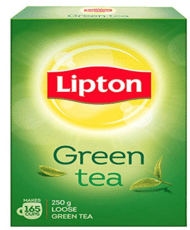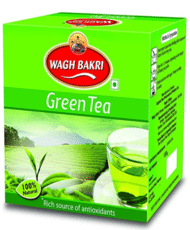Best Everyday Green Tea: Lipton Green Tea

For everyday tea-drinking, whether it is at work between meetings, or at home in the evenings, Lipton Green Tea emerged as the best choice in our review.
Size: 250 grams, Price: Rs. 240*
*At the time of review
Lipton Green Tea is mild, pleases the palate and is value for money – making it our top choice for everyday drinking.
Best Everyday Green Tea: (Runner’s Up) Wagh Bakri

We tested 9 widely-available brands, and Wagh Bakri emerged second best in our entire review process. Interestingly, Wagh Bakri is the only brand amongst all those reviewed that suggests 1/2 of green tea per cup. (The others recommend 1 tsp per cup).
Size: 100 grams, Price: Rs. 90*
*At the time of review
Best Everyday Green Tea: (Gourmet Pick) Cambridge Tea Party

If you don’t mind paying a little more, then Cambridge Tea Party could be a good choice for your everyday green tea too. Cambridge Tea Party had the biggest leaf-size as compared to all the brands we reviewed. When infused, the leaves do look wonderfully plump.
Size: 180 grams, Price: Rs. 249*
*At the time of review
The Brands We Picked:
Lipton Green Tea (Buy on Amazon)
Girnar Pure & fresh Green tea (Buy on Amazon)
Wagh Bakri Green tea (Buy on Amazon)
24 Mantra Organic Green Tea (Buy on Amazon)
Cambridge tea party (Buy on Amazon)
Society premium Green Tea (Buy on Amazon)
LaPlant Green Tea (Buy on Amazon)

For everyday tea-drinking, whether it is at work between meetings, or at home in the evenings, Lipton Green Tea emerged as the best choice in our review.
How We Picked Brands:
We went with well-known brands, easily available across most grocery stores and super markets. Since we were looking for easy-going, entry-level tea brands, we picked brands that are in the most affordable range. Because the grade of tea leaves impacts the quality and ultimately the price of the tea, we made sure the brands picked were price-comparable too – i.e. they belong to the same price category. This way, we wouldn’t compare everyday green teas, which are cheaper and produced for a wider audience, with brands that form the premium segment.
All the brands we picked were easily available at several locations across Delhi-NCR. These are also easily available for audiences outside the national capital region through major online portals as well.
Team Mishry
Green teas come in many flavors, from tulsi to ginger, lemon, mulethi, mint and honey, to name a few. To stay consistent across our review, we only picked ‘pure green tea’ flavors. So, a brand that does not have a classic green tea flavor would not make it to our selected brands.
Who This Is For?
This review is for people who are new to green-tea drinking, which is a large part of India! It’s for people who have been acquainted with the health benefits of drinking green-tea recently and are taking baby-steps towards drinking green teas on a daily basis.
This review is for people who choose green tea leaves over green tea bags. While tea bags are far more convenient, if its flavor you are looking for, tea connoisseurs will always recommend you pick tea leaf over tea bag.
This review is also for people who are looking to find the most affordable green tea leaves.
Related Reading:
19 Incredible Reasons To Start Having Green Tea
Best Time To Drink Green Tea: Easy Green Tea Time Table
Green Tea And Weight loss: 5 Quick & Important Things To Note
Does Your Cup Of Green Tea Taste Bad? 4 Things You May Be Doing Wrong
How We Tested:
Tasting tea and evaluating them for flavor is not an easy task. We know flavour can be subjective and what we liked may not be great for your tastebuds. And that’s why we took the expert advice of a master tea-taster, and we sough her help to standardise the process. We relied on Anamika Singh’s decades of experience in the field. Anamika is not only the founder of Anandini Himalyan Teas, she is also one of India’s top tea sommeliers. Anamika has spent more than 25 years immersed in the world of tea-estates. Her all-round expertise in the field and her knowledge of old and new brands, guided us through the review process. (We love her tasting sessions, and her passion for two leaves and a bud! Read more about her here).
Anamika helped us whet the brands in this category and also advised us on flavor-benchmarking from the list we shared with her.
We went by the instructions on the label for seeping time and quantity of tea to be used per cup. Temperature of hot water was also as per brands’ guidelines.
What Is Flavor Benchmarking:
Tea-masters have flavor benchmarks, a set of expectations to have from the teas to be tasted. The flavor benchmark would need to represent all the qualities – in appearance, aroma and taste – that the teas being reviewed should be as close to as possible. In consultation with Anamika, we picked Gaia (pure green tea variant) as the flavor benchmark.
Parameters Considered:
We observed the teas at three crucial stages;
Stage 1/Dry Leaf: This involved looking at dry and yet to be seeped leaves.
Stage 2/ Infused Tea-leaves: We observed the leaves when they are still hot and plump from infusion.
Stage 3/ Tea: When the decanted liquid has been poured out.
For the Dry Leaf stage, we closely considered these factors:
Color of dry leaves: Remember, Green Tea leaves do not go through the oxidation process that normal black tea leaves do. So the leaves must be visibly lighter, greener in color.
Size of dry leaves: The bigger the leaves, the better it’s appearance. While smaller leaves are expected in this category, too many crushed leaves or powdered remnants is less desirable.
Consistency in shape and style: Whether the size of the leaves is small or medium, consistency across the pack is desirable.
More leaf or stem?: As per our expert, more leaf in a handful of dry green tea leaves as compared to stem scores high.
Infused leaf stage: The appearance of dry leaves may not always be an indication of how the leaves would open out when infused. And that’s why we also observed how the infused leaves of each of the brands looks. In some cases, green tea leaves that otherwise looked dry and brittle, opened up to being healthy-looking, green, plump leaves.
Final Tasting:
Once the teas we brewed as per instructions on the pack and decanted, we looked at factors such as aroma, initial impressions, body, aftertaste, bitterness.
Table of Contents
Mishry Secret Sauce:
First things first – it’s perfectly alright to re-use your green tea leaves. Just make sure you do it within the few hours and not keep them till the next day.
But why re-use tea leaves? For one, it’s less messy, especially at work or away-from-home situations. Secondly, more tea from the same leaves means less wastage and more cost-effectiveness. For many regular green-tea drinkers, and especially those who prefer tea-leaves over tea-bags, there’s always a temptation to re-use the leaves.
This Mishry Secret Sauce test is inspired by this very need. We were looking for teas that would be able to retain as much aroma, flavor, mouthfeel as they offered when brewed for the first time. Do the tea-leaves have it in them to do this? This test would be crucial for people who typically enjoy several cups of green tea a day and would like pull out at least a couple of cups from the same tea leaves.(What’s Mishry Secret Sauce? Read more here…)
This is how we did it: We retained the infused tea leaves and re-used them 4 hours after their first infusion. The teas were kept in a cool place in our review lab.
Result Of Mishry Secret Sauce:
Surprisingly, all brands we tasted for our Mishry Secret Sauce were able too retain as much of their individual flavor and aroma as the first time around. Our top picks – Lipton, Cambridge and Wagh Bakri did well in this test too.
Watch Video: Checking Green Tea Leaves For Their Re-usability | Mishry Secret Sauce
Conclusion: Lipton is our top pick for Best Everyday Green Tea
If you do agree with our review, please give it a thumbs up! If you don’t, please tell us why! And, which one is your favorite from this list.
Food & Beverage is a constantly evolving segment with new categories of products being launched daily. Our endeavor here is to help shoppers buy better. Our reviews are unbiased and all samples used during the reviews were paid for by us. Read our entire ethics statement here.


